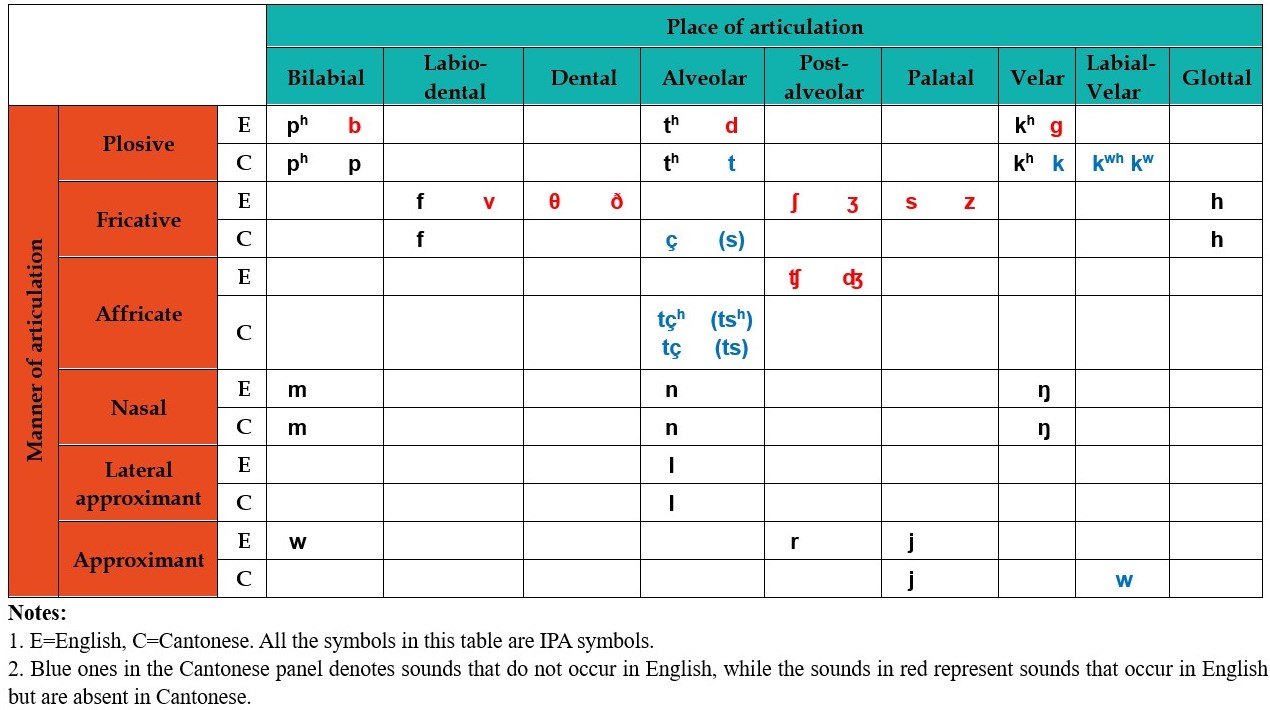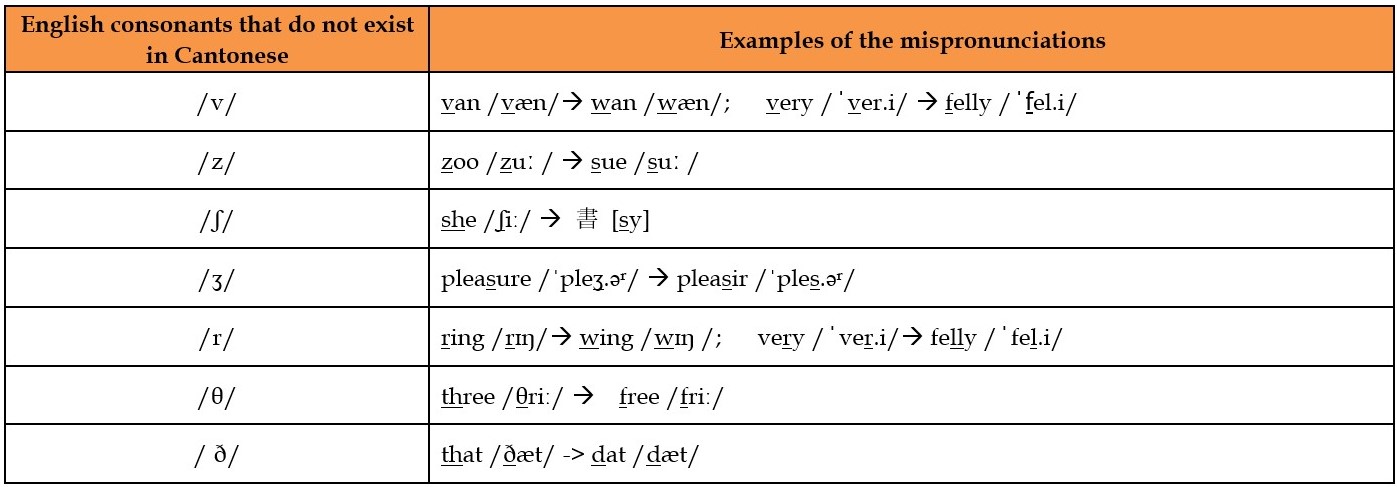Part 1. Consonants
According to Table 1, phonemes in English that are not found in Cantonese include the following 14 consonants: /b/, /d/, /g/, /v/, /s/, /z/, /ʃ/, /ʒ/, /r/, /w/, /ʧ/, /ʤ/, /ð/, and /θ/, but as /b/, /d/, /g/, /s/, /ʧ/, /ʤ/and /w/ have similar counterparts in Cantonese, they do not cause too much trouble for Cantonese speakers.
Table 1. Chart of English and Cantonese consonant phonemes

The following seven English consonants DO NOT exist in Cantonese and DO NOT have similar counterparts in Cantonese, therefore, present some problems for Cantonese ESL learners.
Table 2. English consonants that do not exist in Cantonese

The English /tʃ/ & /dʒ/ are similar to the Cantonese sounds [ts] & [dz]. The English /tʃ/ & /dʒ/ are palato-alveolar, the former is voiceless and the latter is voiced. But the Cantonese [ts] & [dz] are alveolar (i.e. the place of articulation is more fronted), and both are voiceless. Cantonese ESL learners tend to replace /tʃ/ & /dʒ/ by [ts] & [dz] respectively, for example:
- 災 "disaster" [dzɔɪ] vs joy /dʒɔɪ/
- 促 "facilitate" [tsuk] vs choke /tʃəʊk/
/ŋ/ exists in both English and Cantonese. In Cantonese the sound can occur at both the initial or final position of a word, but in English the sound can only occur at the final position of a syllable.
- English – /ŋ/ at the final position e.g. sing /sɪŋ/; hanging /hæŋɪŋ/
- Cantonese – /ŋ/ at the initial position e.g. 我 [ŋo]; 牛 [ŋau]
- Cantonese - /ŋ/ at the final position e.g. 行 [haŋ]
However, many Cantonese speakers tend to mispronounce the final Cantonese /ŋ/ as /n/ → compare 自由行 [haŋ] &自由痕 [han], 朋友 [paŋ] & 貧友[pan].
/n/ also exists in both English and Cantonese. However, many Cantonese speakers tend to replace /n/ with /l/ e.g. there is often an unclear distinction between:
- 男, 南 [naam] vs 藍, 婪 [laam]
- 你, 尼 [nei] vs 李, 梨 [lei]
This unclear distinction between /n/ & /l/ can also be found when Cantonese ESL learners speak English, for example: I’m sorry, I don’t low (I don’t 撈) /ləʊ/ vs know /nəʊ/.
Voicing
In English, the consonants /b d g/ are voiced. These sounds also exist in Cantonese but they are not voiced. In English, the main distinctions between /p/ & /b/ are voicing and aspiration, but in Cantonese, [p] & [b] mainly differ in aspiration, both sounds are voiceless. This difference leads to a tendency in many Cantonese ESL learners to have weak voicing for voiced English consonants, for example:
- duck /dʌk/ becomes 得 [dak]
- but /bʌt/ becomes 拔 [bat]
Final consonants
There are 6 final consonants in Cantonese –給 [p]; 別 [t]; 陸 [k]; 心 [m]; 陳 [n]; 張 [ŋ].
It is important to note that in Cantonese, final plosives [p]; [t]; [d] are NOT RELEASED. For example, to say the word 給 [kap], the lips are closed at the end, ready to produce the final plosive [p], but the lips are not opened again and there is no release of air, as in the case of English plosives. Similarly, to say the words 別 [bit] and 陸 [luk], there is no release of air when [t] and [k] are produced.
Many Cantonese ESL learners tend to carry this habit to their pronunciation of English words, and the final consonants are often deleted. However, this loss of final consonants in English can cause misunderstandings. For example, the following words will have the same sounds if the final consonants are deleted.
- Deletion of the final /p/ in help /help/ will change the word to /hel/ hell
- Deletion of the final /l/ in tool /tu:l/ will change the word to /tu:/ too/two
- If the final consonants of the following words are deleted, they will become indistinguishable – dog /dɒɡ/; dot /dɒt/; doc /dɒk/ → /dɒ/
Another common problem is just the opposite – instead of dropping the final consonants, some speakers may over-emphasise the final consonant, resulting in addition of unnecessary sounds (epenthesis), for example:
- orange /ˈɒrɪndʒ/ becomes /ˈɒrɪndʒju/
- girl /gɜːl/ becomes /gɜːləʊ/
- miss /mɪs/ becomes /mɪˈsi:/
- fax /fæks/ becomes /fækˈsi:/
Consonant clusters (Blend)
Consonant clusters are very common in English. They can be at the initial, medial or final positions of a word, and they can consist of a cluster of two or more consonants:
e.g. play /pleɪ/; string /strɪŋ/; handbag /hændbæg/; last /lɑːst/; text /tekst/. The word texts /teksts/ has a final blend of four consonants!
However, in Cantonese there are no consonant clusters. Some people may take the initial sounds of 國; 果 [gw] and 葵; 誇 [kw] as initial consonant clusters. But most people will regard them as consonant digraphs rather than consonant clusters.
Because of this lack of consonant clusters in Cantonese, many Cantonese ESL learners find pronunciation of English consonant clusters to be a great challenge. They tend to simplify the consonant clusters by dropping a consonant sound in the cluster, for example:
- I have a Jim / gym. /dʒɪm/ vs dream /dri:m/
- One, two, fee… go! /fi:/ vs three /θri:/
- I like to pay football. /peɪ/ vs play /pleɪ/
- This is my girl fan. /fæn/ vs friend /frend/
- Women are so 查煲. [tsa bou] vs trouble /trʌbl/
Part 2. Vowels and Diphthongs
Since there are no distinctive length contrasts in Cantonese words, e.g. 別 [bit]; 活 [wut]; 落 [lok], many Cantonese learners fail to distinguish between the following long and short vowel pairs in English:
- /ɪ/ and /iː/ e.g. Please sit in this seat. /sɪt/ vs /si:t/
- /ʊ/ and /uː/ e.g. They pull me to the swimming pool. /pʊl/ vs /pu:l/
- /ɒ/ and /ɔː/ e.g. He shot from a short distance. /ʃɒt/ vs /ʃɔːt/
There are also some cases of confusion of when the vowel digraph "oo" is /ʊ/, and when it is /u:/, e.g. good /gʊd/ vs food /fu:d/, foot /fʊt/ vs boot /bu:t/.
Many Cantonese learners find it difficult to distinguish between /æ/ and /e/. Many tend to substitute /e/ for /æ/, e.g.
- man /mæn/ vs men /men/
- fan /fæn/ vs friend /frend/
Some Cantonese learners may confuse /ɜː/ with /ɔː/. The following are two authentic examples that had caused misunderstanding:
A student wanted to apply for a day of leave, he told his lecturer:
- I need to go to Wanchai to /wɔːk/ (walk for work).
- After a meeting, a clerk told her boss:
- A /wɔːkmən/ (walkman for workman ) is waiting for you.
Probably due to the influence of the Chinese words 耳/醫 [ji], many Cantonese learners tend to insert /j/ before words that start with the vowels /ɪ/ and /i:/, e.g.
- ear /ɪə/ becomes /jɪə/ (year)
- east /i:st/ becomes /ji:st/ (yeast)
- 二E班 /i:/ becomes /ji:/ (二醫班)
Cantonese learners tend to replace the diphthong /ɔɪ/ with a similar shorter vowel /ɒ/, e.g.
- join /dʒɔɪn/ vs John /dʒɒn/
- point /pɔɪnt/ vs pond /pɒnd/
Cantonese learners often have problems with the diphthong /eɪ/, especially when it is followed by a nasal /m/, /n/ or a lateral /l/, e.g.
- name /neɪm/ often becomes /næm/ (nam), or even /læm/ (lam / lamb)
- claim /kleɪm/ often becomes /klæm/ (clam), or even /kæm/ (cam)
- fail /feɪl/ often becomes /fel/ (fell)
English diphthongs /aʊ/, /aɪ/, /eɪ/ exist in Cantonese but tend to be pronounced with quicker and smaller lip and jaw movements. Influenced by their L1 (first language), many Cantonese learners tend to have problems with the following words:
- sound /saʊnd/ often becomes 生 [saŋ]
- timetable /taɪm/ often becomes 貪table [tam]
- e-mail /meɪl/ often becomes e-貓 [mau]
- a birthday cake /keɪk/ turns to be a birthday kick /kɪk/
Hits: 21005
